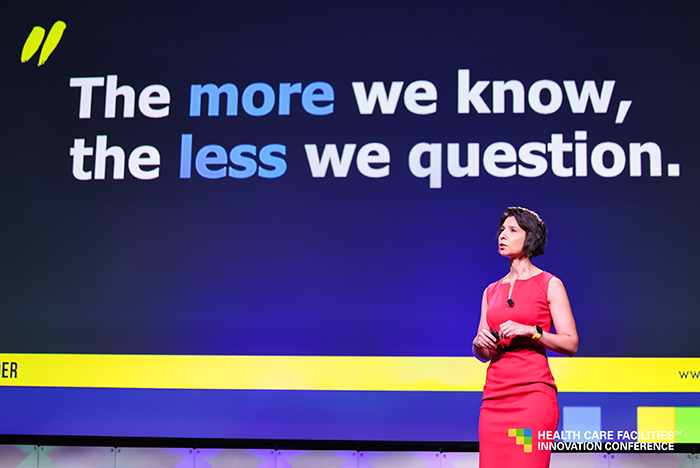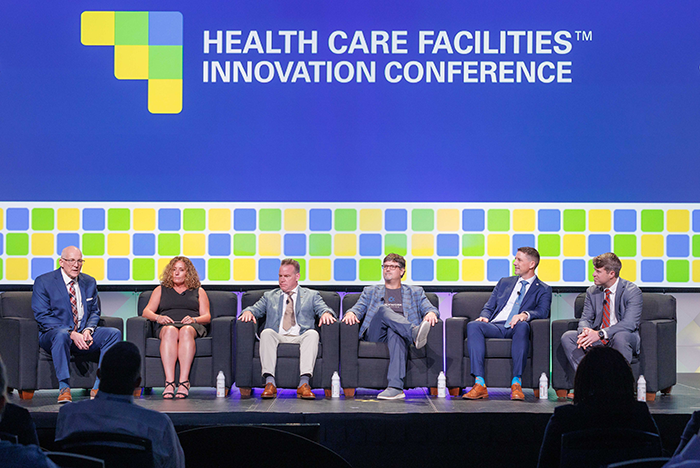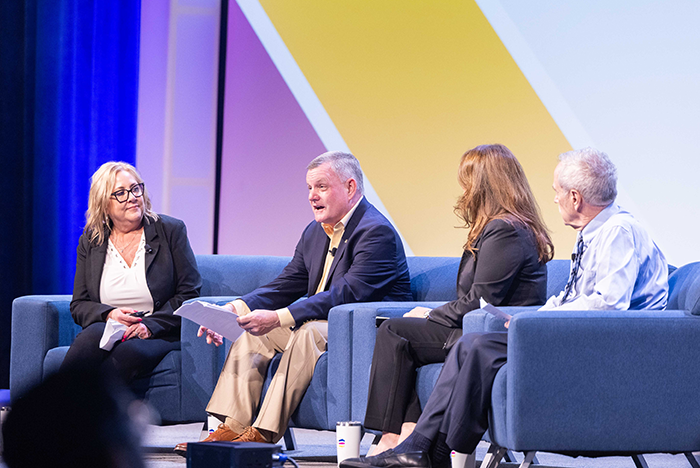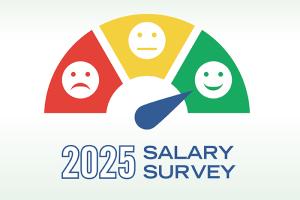A wrap-up of the 2025 Health Care Facilities Innovation Conference

Speaker Diana Kander delivered the 2025 Health Care Facilities Innovation Conference keynote with a message on how to drive results and innovation.
Image courtesy of ASHE
"Those who know me in my capacity as ASHE president have heard my mantra, 'Back to basics — with innovation,'" said American Society for Health Care Engineering (ASHE) President Michael A. Hatton, MBA, CHFM, FASHE, during the opening session at the Health Care Facilities Innovation Conference™ July 27-30 in Columbus, Ohio. "Health care is changing rapidly, and success requires us to embrace a forward-thinking mindset while pursuing mastery over the fundamentals."
Toward that end, ASHE offered more than 3,000 attendees a packed conference and exhibition program designed to help them meet the opportunities and challenges presented by the rapidly changing health care field, from high-level views of management and finance trends to detailed looks at technologies, regulations and real-world solutions.
In her opening keynote, innovation author, speaker and consultant Diana Kander set the tone with a high-energy program showing attendees how to improve results and drive innovation.
"There is one thing that keeps us from growing and innovating and that is our own success," Kander said. "The more that we know, the less we question."
A byproduct of this success are "zombies," which Kander defined as any use of time and resources that doesn't produce enough value in return. To help remove these unhelpful endeavors, Kander suggests ranking projects on a 1 to 10 scale by level of importance rather than asking a simple "yes" or "no" question about whether it should be continued.
Once these zombies are eliminated, Kander said, health care facilities professionals and their teams can reimagine what's possible by asking themselves: "What does version 2.0 look like?"
"I literally want you to pick a different process, like one chunk of what you do in your organization, and start with a blank sheet of paper," Kander continued. "I want you to bring in all [your] people and I want you to say, 'How do we reimagine what this service or process looks like?'"
This collaboration is even more significant in the third step of the improvement process, which Kander introduced by relating the story of a children's hospital in England that reduced its patient hand off issues by bringing in a Formula One racing team to observe their processes and help them develop a "pit crew" to improve hand offs.
"Whether it's finding good talent or trying to deal with a lot more needs with fewer resources, our natural inclination is to say, 'I'm going to think my way out of it and I'm going to work however many hours it takes," she said. "There is a better way — the innovator way — which is to ask, 'Who can help me do this?'"
After discussing how she used a collaborative process to reach one of her personal goals, Kander wrapped up by urging attendees to foster their own growth.
"Everybody understands that change is inevitable, but we assume that we've evolved with the times. And I'm here to tell you 'no,'" Kander concluded. "Change is inevitable, but our growth is optional."
In fact, change and growth were key areas of focus throughout the conference. During a wide-ranging general session later that day on "Moving the Needle in Asset Management," a panel of facilities professionals discussed strategies professionals can use to shift their practices to methods that ensure business continuity and improve the financial bottom line for the next generation of facilities managers.

Panelists share best practices in the "Moving the Needle in Asset Management" general session at the 2025 Health Care Facilities Innovation Conference.
Image courtesy of ASHE
"This group will be covering four areas that are pivotal in our success," said moderator Dave Lockhart, CHFM, CEM, FASHE, executive director for facilities operations and maintenance — national shared service operations at Kaiser Permanente. "Our people, our data, tools and the measurement of what we're doing."
Referring back to Kander's presentation, Lockhart started out by stressing the need to remove zombie operations.
"There are tools that are available for all of us to get out of doing the same old thing," Lockhart said. "Let's look at other tools and techniques of how we can improve what we are doing and how we are doing it, because they will make a difference in our organizations."
Panelist Ryan Schramm, CHFM, CHC, MECH, FASHE, facilities systems director at Banner Health, expanded on this introduction by discussing how facilities professionals need to move from firefighting to fire prevention. Schramm talked about efforts to develop asset data standards as part of this transition.
Focusing on employee development, panelist Michele Mucia, CHSP-FM, HACP, MS, senior director of health care industry solutions at Nuvolo, pointed to the need to quantify performance. "As we have new people coming into the facilities management field, not everyone learns the same and they're not at the same level of skill sets," she said. "So how do we measure ourselves throughout the year and how do we measure each person?"
Topics later in the session included the importance of staff education and training, the need for accurate data, taking full advantage of computerized maintenance management system (CMMS) capabilities and reliability-centered maintenance.
Also on the panel were Ryan Sutherland, MHA, LSSBB, director of program management and strategy execution at Kaiser Permanente; Devin Hugie, MBA, FASHE, CRL, CHFM, CHC, chief executive officer and reliability coach at Forum Reliability; and Nick Gayeski, Ph.D., CEO of Clockworks Analytics.
The second day of the conference kicked off with a keynote titled "Supersonic Success" by combat-decorated fighter pilot and performance improvement consultant Jack Becker, who discussed the protocols that enable elite military aviators to optimize performance and execute under pressure while continually accelerating improvement.
"I'm not [going to] teach you how to fly an F/A-18 today," Becker said. "But I'm going to take you on a mission to eliminate your mistakes."
To help, Becker walked attendees through the crew resource management process, which focuses on seven critical skills that reduce mistakes on the job, including communication, assertiveness, leadership, decision-making, task analysis, adaptability/flexibility and situational awareness.
"This process helps us capture errors in a high-risk challenging environment," he said. "But it also provides collaboration across several different areas of expertise."
Diving further into the fighter pilot's pursuit of perfection, Becker also covered the "top gun" process of brief, execute, debrief and perfect.
"I want you to think about how you can best apply this process to your team," he added, calling it a "constant cycle of getting better every day when we do things."
Also on the second day of the conference, Joe Powell, chairman at University Research Institute, Washington, D.C., led an interactive panel discussion on "Communicating Facilities as a Value Driver to Executive Leadership."
"Our session has three learning objectives," said Powell. "Number one, effective communication with [executive leadership]; number two, the [executive leadership's] objectives and their decision-making processes; and, number three, how to align the facility strategy with organizational goals."
"It starts with data integrity — you have to have the CMMS system, you have to have the asset management system," said panelist Matthew Snow, PE, MBA, FACHE, CEM, LEED AP, system vice president of support services at Baptist Health System in Kentucky and Indiana. "Data integrity is a must because you have to use that to gain trust with [executive leadership]."
Once that trust is established, Snow said he's been able to review the key assets that are past their useful lives with the compliance, risk management and insurance professionals in his organization, telling them what might happen if there were to be failures.
Through such a presentation "all the way up to the board level," Snow said his organization has been able to develop a long-term plan to improve the infrastructure picture and get the facility to a better situation.
Panelist Andy Woommavovah, MS, CHFM, SASHE, system vice president at CommonSpirit Health, agreed with Snow, adding that due to Common Sprit's multiple executive leaders at the local, market and national levels, he focuses on a "CCI approach" of content, context and impact.
"So, if we're communicating in those three channels, the content is don't get too technical," he continued. "Make sure you're speaking in their terms of return on investment."
Context ensures the request is connected to the organization's initiatives, Woommavovah added, and impact is where facilities professionals explain the true savings.
"I think we have to be storytellers," added panelist Josh King, CHFM, vice president of facilities planning and development at Appalachian Regional Healthcare, based in Kentucky and West Virginia. "So, I almost picture myself as an artist and [envision] how am I going to tell this story to the [executive leadership]."
Damian Skelton, vice president at HCA, was also on the panel.
The third day of the conference included the popular "Just Ask ASHE" session featuring ASHE’s codes and standards experts discussing emerging codes and standards issues facing health care facilities and answers to specific questions.
Also during the Health Care Facilities Innovation Conference:
- Numerous individuals and ASHE Chapters were honored for their own stellar performance.
- A full schedule of technical sessions was held over four knowledge levels, empowering attendees to choose a personalized conference experience while earning continuing education credits.
- The technical exhibition featured dynamic, interactive demonstrations from vendors and business partners servicing the areas of fire protection; heating, ventilating and air conditioning; power and electrical equipment; health care lighting, furnishings and flooring; building automation; safety and security; and many others.
- An active schedule of pre- and post-conference events was held.
Save the date for the 2026 Health Care Facilities Innovation Conference taking place Aug. 2-5, 2026, in Minneapolis.





